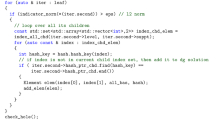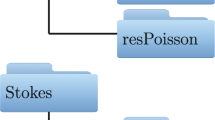
Overview
- The construction of element matrices and the resulting matrices are shown for all the differential operators discussed. This helps the reader understand the material clearly and assists them in building their numerical algorithms
- Both modal and nodal basis functions are discussed throughout the text, including examples for the continuous and discontinuous Galerkin method, it is shown how to combine both of these methods into one piece of code; moreover, a description of hybridized discontinuous Galerkin method is included in this textbook. A sample solution along with the order of accuracy and time-to-solution (work-precision diagrams) are shown for a variety of test problems for different types of equations (e.g., hyperbolic and elliptic)
- Sample code for student projects are provided on my Github page with code in both matlab and Julia (see https://github.com/fxgiraldo/Element-based-Galerkin-Methods)
Part of the book series: Texts in Computational Science and Engineering (TCSE, volume 24)
Access this book
Tax calculation will be finalised at checkout
Other ways to access
About this book
This book introduces the reader to solving partial differential equations (PDEs) numerically using element-based Galerkin methods. Although it draws on a solid theoretical foundation (e.g. the theory of interpolation, numerical integration, and function spaces), the book’s main focus is on how to build the method, what the resulting matrices look like, and how to write algorithms for coding Galerkin methods. In addition, the spotlight is on tensor-product bases, which means that only line elements (in one dimension), quadrilateral elements (in two dimensions), and cubes (in three dimensions) are considered. The types of Galerkin methods covered are: continuous Galerkin methods (i.e., finite/spectral elements), discontinuous Galerkin methods, and hybridized discontinuous Galerkin methods using both nodal and modal basis functions. In addition, examples are included (which can also serve as student projects) for solving hyperbolic and elliptic partial differential equations, includingboth scalar PDEs and systems of equations.
Similar content being viewed by others
Keywords
Table of contents (21 chapters)
-
Front Matter
-
Introduction
-
Front Matter
-
-
One-Dimensional Problems
-
Front Matter
-
-
Multi-Dimensional Problems
-
Front Matter
-
Authors and Affiliations
About the author
Bibliographic Information
Book Title: An Introduction to Element-Based Galerkin Methods on Tensor-Product Bases
Book Subtitle: Analysis, Algorithms, and Applications
Authors: Francis X. Giraldo
Series Title: Texts in Computational Science and Engineering
DOI: https://doi.org/10.1007/978-3-030-55069-1
Publisher: Springer Cham
eBook Packages: Mathematics and Statistics, Mathematics and Statistics (R0)
Copyright Information: The Editor(s) (if applicable) and The Author(s), under exclusive license to Springer Nature Switzerland AG 2020
Hardcover ISBN: 978-3-030-55068-4Published: 31 October 2020
Softcover ISBN: 978-3-030-55071-4Published: 01 November 2021
eBook ISBN: 978-3-030-55069-1Published: 30 October 2020
Series ISSN: 1611-0994
Series E-ISSN: 2197-179X
Edition Number: 1
Number of Pages: XXVI, 559
Number of Illustrations: 3 b/w illustrations, 168 illustrations in colour
Topics: Partial Differential Equations, Computational Science and Engineering, Numerical Analysis



